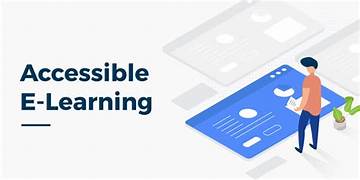How Can E-learning be More Accessible for Students with Disabilities?
E-learning has transformed education by offering flexible, scalable, and personalized learning opportunities. However, for students with disabilities, e-learning platforms often present barriers that hinder their ability to fully engage. Making e-learning accessible to all requires deliberate design, inclusive practices, and supportive technologies. This article explores how e-learning can be made more accessible for students with disabilities, highlighting key challenges, strategies, and benefits.
Understanding the Challenges
To make e-learning inclusive, it is essential to first understand the challenges faced by students with disabilities. These challenges include:
1. Inaccessible Content
E-learning materials such as videos, images, and PDFs are often not designed with accessibility in mind. For instance:
- Videos without captions or transcripts exclude students who are deaf or hard of hearing.
- Images without alt text are inaccessible to those who rely on screen readers.
2. Navigation Barriers
Students with mobility impairments or visual disabilities may struggle to navigate complex user interfaces. Poorly designed navigation systems can make it difficult to access content or complete tasks.
3. Lack of Assistive Technology Integration
E-learning platforms that do not support assistive technologies, such as screen readers, magnifiers, or speech-to-text software, leave students unable to fully engage with the material.
4. Limited Customization Options
Many platforms lack features that allow students to adjust font size, contrast, or playback speed, making it difficult for those with specific learning needs or visual impairments to access content comfortably.
5. Insufficient Training for Educators
Educators often lack the knowledge or resources to create accessible content, leading to unintentional barriers in course design.
Strategies for Improving Accessibility
To address these challenges, e-learning platforms, educators, and institutions can adopt several strategies:
1. Designing with Accessibility in Mind
Incorporating universal design principles ensures that e-learning environments are accessible to all students. Key practices include:
- Providing alternative text for images.
- Using descriptive headings and clear layouts for better navigation.
- Ensuring compatibility with screen readers.
2. Implementing Multimedia Accessibility
Multimedia content should be accessible to students with different types of disabilities. Strategies include:
- Adding captions and transcripts to videos.
- Ensuring audio descriptions are available for visual content.
- Allowing adjustable playback speeds for audio and video materials.
3. Integrating Assistive Technologies
E-learning platforms should seamlessly integrate with assistive technologies. For example:
- Screen readers should be able to navigate all elements of the platform.
- Text-to-speech features can benefit students with reading disabilities.
- Voice recognition software can assist students with mobility impairments.
4. Providing Customization Options
Platforms should offer customizable settings to accommodate individual needs, such as:
- Adjustable text size, font style, and background colors.
- Options to change contrast settings for better visibility.
- Flexible timing for quizzes and assignments to accommodate different learning paces.
5. Training Educators and Developers
Educators and platform developers must understand the importance of accessibility and how to implement it effectively. This can be achieved through:
- Workshops and training programs on accessible content creation.
- Collaboration with accessibility experts during platform design.
Role of Technology in Accessibility
Technology plays a critical role in making e-learning accessible. Innovative tools and approaches include:
1. Artificial Intelligence (AI)
AI can enhance accessibility by:
- Automatically generating captions and transcripts for videos.
- Personalizing learning experiences based on individual needs.
- Identifying and addressing accessibility issues in real time.
2. Virtual Reality (VR) and Augmented Reality (AR)
VR and AR can provide immersive experiences for students with disabilities by:
- Simulating real-world environments for experiential learning.
- Offering tactile feedback for students with sensory impairments.
3. Cloud-Based Solutions
Cloud-based platforms enable:
- Easy access to content from any device, ensuring flexibility.
- Seamless integration with assistive tools and plugins.
Benefits of Accessible E-learning
Accessible e-learning benefits not only students with disabilities but also the broader educational community. Key advantages include:
1. Inclusivity
By removing barriers, e-learning platforms foster an inclusive environment where all students can thrive.
2. Improved Engagement
Accessible content and tools enhance engagement for all learners, including those without disabilities.
3. Legal and Ethical Compliance
Adhering to accessibility standards, such as the Web Content Accessibility Guidelines (WCAG), ensures legal compliance and demonstrates a commitment to equity.
4. Enhanced Innovation
Focusing on accessibility drives technological innovation, resulting in better learning experiences for everyone.
Examples of Accessible E-learning Platforms
Several platforms stand out for their commitment to accessibility:
- Blackboard: Offers tools for creating accessible content and supports screen readers.
- Moodle: Features plugins for accessibility and customizable interfaces.
- Canvas: Includes accessibility checkers and integrates with assistive technologies.
Overcoming Challenges in Implementation
While the benefits of accessible e-learning are clear, implementation can be challenging. Common obstacles and solutions include:
1. Cost Constraints
Developing accessible content and technologies can be expensive. Solutions include:
- Prioritizing key accessibility features.
- Seeking grants or funding dedicated to accessibility initiatives.
2. Resistance to Change
Institutions may resist adopting new practices due to inertia or lack of awareness. This can be addressed through:
- Awareness campaigns highlighting the importance of accessibility.
- Demonstrating the positive impact on student outcomes.
3. Technical Limitations
Older platforms may lack the capability to support advanced accessibility features. Solutions include:
- Upgrading to modern platforms.
- Using third-party tools to enhance existing systems.
The Future of Accessible E-learning
The future of e-learning lies in creating inclusive, equitable platforms that cater to diverse learning needs. Emerging trends include:
1. AI-Driven Personalization
AI will enable platforms to adapt dynamically to individual accessibility needs, providing a tailored learning experience.
2. Universal Design Adoption
As awareness grows, universal design principles will become standard practice in e-learning development.
3. Increased Collaboration
Collaboration between educators, technologists, and accessibility experts will drive innovation and improve outcomes.
Conclusion
Making e-learning accessible for students with disabilities is not just a legal or ethical obligation but a transformative opportunity to create a more inclusive educational landscape. By understanding challenges, leveraging technology, and adopting best practices, educators and developers can ensure that e-learning platforms empower every student to reach their full potential. As accessibility becomes integral to e-learning, the vision of education for all can become a reality.


